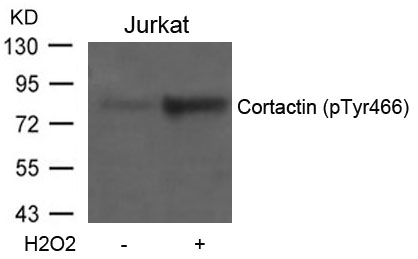anti-Cortactin phospho (Tyr466) antibody
CAT.NO. : ARG51755
US$ Please choose
US$ Please choose
概述
| 产品描述 | Rabbit Polyclonal antibody recognizes Cortactin phospho (Tyr466) |
|---|---|
| 反应物种 | Hu, Ms |
| 应用 | WB |
| 宿主 | Rabbit |
| 克隆 | Polyclonal |
| 同位型 | IgG |
| 靶点名称 | Cortactin |
| 抗原物种 | Human |
| 抗原 | Peptide sequence around phosphorylation site of tyrosine 466 (P-V-Y(p)-E-T) derived from Human CORTACTIN. |
| 偶联标记 | Un-conjugated |
| 別名 | EMS1; Amplaxin; Src substrate cortactin; Oncogene EMS1 |
应用说明
| 应用建议 |
| ||||
|---|---|---|---|---|---|
| 应用说明 | * The dilutions indicate recommended starting dilutions and the optimal dilutions or concentrations should be determined by the scientist. |
属性
| 形式 | Liquid |
|---|---|
| 纯化 | Antibodies were produced by immunizing rabbits with KLH-conjugated synthetic phosphopeptide. Antibodies were purified by affinity-chromatography using epitope-specific phosphopeptide. In addition, non-phospho specific antibodies were removed by chromatogramphy using non-phosphopeptide. |
| 缓冲液 | PBS (without Mg2+ and Ca2+, pH 7.4), 150mM NaCl, 0.02% Sodium azide and 50% Glycerol. |
| 抗菌剂 | 0.02% Sodium azide |
| 稳定剂 | 50% Glycerol |
| 浓度 | 1 mg/ml |
| 存放说明 | For continuous use, store undiluted antibody at 2-8°C for up to a week. For long-term storage, aliquot and store at -20°C. Storage in frost free freezers is not recommended. Avoid repeated freeze/thaw cycles. Suggest spin the vial prior to opening. The antibody solution should be gently mixed before use. |
| 注意事项 | For laboratory research only, not for drug, diagnostic or other use. |
生物信息
| 数据库连接 | |
|---|---|
| 基因名称 | CTTN |
| 全名 | cortactin |
| 背景介绍 | Cortactin is overexpressed in breast cancer and squamous cell carcinomas of the head and neck. The encoded protein is localized in the cytoplasm and in areas of the cell-substratum contacts. This gene has two roles: (1) regulating the interactions between components of adherens-type junctions and (2) organizing the cytoskeleton and cell adhesion structures of epithelia and carcinoma cells. During apoptosis, the encoded protein is degraded in a caspase-dependent manner. The aberrant regulation of this gene contributes to tumor cell invasion and metastasis. Two splice variants that encode different isoforms have been identified for this gene. |
| 生物功能 | Contributes to the organization of the actin cytoskeleton and cell shape (PubMed:21296879). Plays a role in the formation of lamellipodia and in cell migration. Plays a role in the regulation of neuron morphology, axon growth and formation of neuronal growth cones (By similarity). Through its interaction with CTTNBP2, involved in the regulation of neuronal spine density (By similarity). Plays a role in the invasiveness of cancer cells, and the formation of metastases (PubMed:16636290). Plays a role in focal adhesion assembly and turnover (By similarity). In complex with ABL1 and MYLK regulates cortical actin-based cytoskeletal rearrangement critical to sphingosine 1-phosphate (S1P)-mediated endothelial cell (EC) barrier enhancement (PubMed:20861316). Plays a role in intracellular protein transport and endocytosis, and in modulating the levels of potassium channels present at the cell membrane (PubMed:17959782). Plays a role in receptor-mediated endocytosis via clathrin-coated pits (By similarity). Required for stabilization of KCNH1 channels at the cell membrane (PubMed:23144454). [UniProt] |
| 研究领域 | Cancer antibody; Signaling Transduction antibody |
| 预测分子量 | 62 kDa |
| 翻译后修饰 | Phosphorylated by PKN2 at both serine and threonine residues in a GTP-bound Rac1-dependent manner in hyaluronan-induced astrocytes and hence down-regulated CTTN ability to associates with filamentous actin (By similarity). Phosphorylated on tyrosine residues in response to CHRM1 activation (By similarity). Phosphorylated by PTK2/FAK1 in response to cell adhesion (By similarity). Phosphorylated by FER. Tyrosine phosphorylation in transformed cells may contribute to cellular growth regulation and transformation. Phosphorylated in response to FGR activation. Phosphorylation by SRC promotes MYLK binding. |
检测图片 (2)
ARG51755 anti-Cortactin phospho (Tyr466) antibody WB image
Western blot: Extracts from Jurkat cells untreated or treated with H2O2 stained with ARG51755 anti-Cortactin phospho (Tyr466) antibody.
ARG51755 anti-Cortactin phospho (Tyr466) antibody WB image
Western blot: Extracts from JK cells, treated with H2O2 or calf intestinal phosphatase (CIP), stained with ARG51755 anti-Cortactin phospho (Tyr466) antibody.
 New Products
New Products























